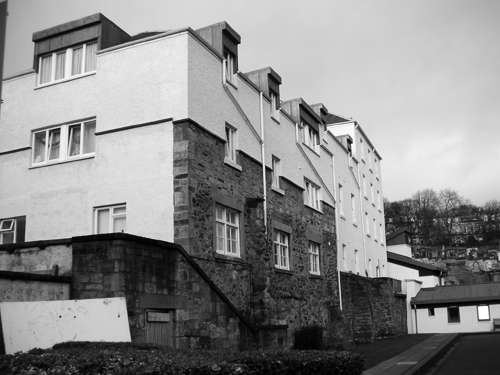| |
|
Whitefoord House,
Canongate, Edinburgh |
|

 Once
the site of the Earl of Wintons' mansion, known as Lord Seton's
Lodging (featured in Walter Scott's 'Abbot' - Vol.1 chapter xviii.
), Whitefoord is located only a short walk from the official
Residence of the Scottish Monarch's at the Palace of Holyrood
House. It was here that Lord Darnley spent the night
before his wedding to Mary, Queen of Scots, at Holyrood Palace
in 1565. It was a famed residence for foreign Ambassadors,
who's host were the Lord's Seton, and in particular a favourite
with the French Ambassadors, and Manzeville sojourned there in
1583. It's proximity to the Royal Palace gave the family a
futher close presence to the Monarch, and was a much coveted
property of the Canongate. The townhouse had several noted
events pass through it's doors, it was the first place of refuge
for Queen Mary after the murder of her favourite David Rizzio, and
welcomed that Queen for a private reception after her marriage to
Lord Darnley. After the forfeiture of the 5th Earl of
Winton, the lodging fell into disrepair (1715-1744) and was
finally sold to the British Linen Company. The present
house was built in 1766 for Sir John Whitefoord of Ballochmyle,
an early patron of poet Robert Burns, by the architect Robert
Mylne using much of the existing building of the Seton's. Once
the site of the Earl of Wintons' mansion, known as Lord Seton's
Lodging (featured in Walter Scott's 'Abbot' - Vol.1 chapter xviii.
), Whitefoord is located only a short walk from the official
Residence of the Scottish Monarch's at the Palace of Holyrood
House. It was here that Lord Darnley spent the night
before his wedding to Mary, Queen of Scots, at Holyrood Palace
in 1565. It was a famed residence for foreign Ambassadors,
who's host were the Lord's Seton, and in particular a favourite
with the French Ambassadors, and Manzeville sojourned there in
1583. It's proximity to the Royal Palace gave the family a
futher close presence to the Monarch, and was a much coveted
property of the Canongate. The townhouse had several noted
events pass through it's doors, it was the first place of refuge
for Queen Mary after the murder of her favourite David Rizzio, and
welcomed that Queen for a private reception after her marriage to
Lord Darnley. After the forfeiture of the 5th Earl of
Winton, the lodging fell into disrepair (1715-1744) and was
finally sold to the British Linen Company. The present
house was built in 1766 for Sir John Whitefoord of Ballochmyle,
an early patron of poet Robert Burns, by the architect Robert
Mylne using much of the existing building of the Seton's.
Whitefoord died here in 1803, and it was then home to the
noted judge Sir William MacLeod Bannatyne (1743 - 1833) who died
in the house at the age of 90. Thereafter, around 1850, the
building was converted for use as a type foundry. Located on the
north side of Edinburgh's Canongate, Whitefoord House was the
first of the Scottish Veteran's Residences, having been
purchased by that charity in 1910. Today this
three-storey white-harled building, with its Roman-Doric
porch, provides residential accommodation and support for 85
ex-servicemen of all
ages, who are veterans of campaigns around the
world.
The first Lady Haig Poppy Factory was established at
Whitefoord House in 1926, by the wife of Field Marshal Douglas
Haig (1861 - 1928). Here the residents made poppies for sale
throughout Scotland to raise money to support their fellow
ex-servicemen. The house has been extended to accommodate
couples, with further
phases of redevelopment expected to be completed in 2005.
|
|
 |
 |
Whitefoord House Website

Map of the Canongate

Photo's of Whitefoord

The Floorplan

Notes regarding Seton's
Lodging
Old Map of Edinburgh

|